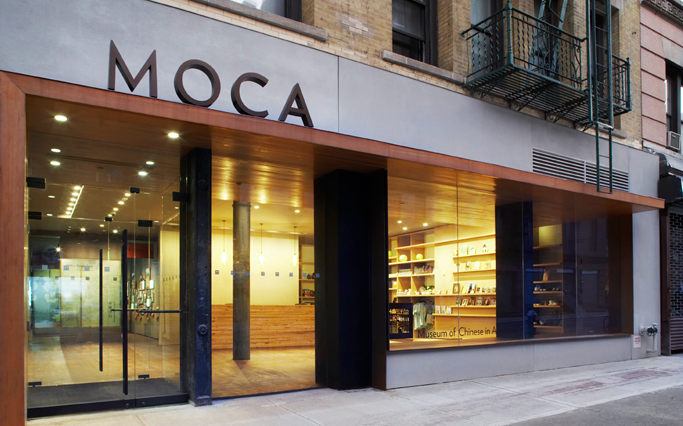
The Museum of Chinese in America faces Chinatown from the front, and Soho from the back. Designed by Maya Lin ‘81, ARCH ‘86, ART ‘87, MOCA has all the wood paneling, airy floor to ceiling windows and sans serif font requisite for hipster approval. From the street, it’s clear that MOCA is no Chinese kitchen supply store or supermarket; its sleek metal sign stands out among the colorful awnings of the neighboring stores.Founded as the New York Chinatown Historical Project in 1980, the museum began as a home for the neighborhood’s artifacts and stories that were being lost as the older generation passed.
Between dumpster diving and oral history recording, historians Charles Lai and Jack Tchen gained the support of student activists and neighborhood residents, and the Chinatown Historical Project found a home in an old school building in central Chinatown. Over the years, it changed its name to the Museum of Chinese in America. After 9/11, MOCA was chosen by the city and state to help anchor the revival of downtown New York. The museum moved into its current building at 215 Centre Street in 2009, and now welcomes 30,000 visitors a year.
On a summer Friday at noon, the museum floor clicks with the shoes of security guards and not much else. Two parents with their adopted Chinese daughters wander through the exhibit: one girl inspects an old laundry iron, marveling over its lack of plastic parts and flashing lights, while the other oohs and aahs over the silk shoes in Shanghai Glamour: New Women 1910s-40s, an exhibit on women’s fashion in the early twentieth century Shanghai. The parents read the plaques in murmured voices to their children. “Isn’t that neat, girls?”
MOCA’s collection includes oral histories by Chinatown residents, who detail their immigration experience and life in a country where they were viewed with suspicion, mockery, and outright hostility. The histories have been translated into English, and recordings play throughout the museum, integrated into various exhibits. Polished, Northeastern voices take on stories of racism and the struggle for assimilation, and you’re faintly reminded of translators whose voices run in documentaries, as the camera remains steady on the native interviewee. Something seemed lost in translation.
Some recordings are striking: you’re told to sit in a chair and suddenly an interrogation begins, as a disembodied immigration officer hurls inane and impossibly detailed questions at you, determined to ensnare you in a lie and send you on the next ship home. The clipped voice sounds familiar, similar to the ones in the other recordings.
In the back is the general store, a recreation of the buildings that served as shop, post office, pharmacy and travel agency for the local community. It’s gorgeously installed, with exposed brick, enough shelving to make an Ikea junkie jealous, and a stunningly patterned tin ceiling seemingly made for Instagram. Faded medicinal recipes and letters lie under glass cases; apothecary jars hold roots and shoots for herbal soups. The vintage packaging is a design lover’s dream.
Such general stores may be a thing of the past, but their modern counterparts are alive and well: from garages of herbalists overflowing with dried herbs to bustling medicinal stores where assistants measure ingredients on hand-held scales, there’s a vitality and messiness the museum’s replica could not capture. Its perfection calls to mind a trendy Tribeca shop, or the set of a photoshoot, not the Chinatown stores of steaming pork buns or freshly killed fish.
The mission of heritage museums is to preserve and to educate, and to direct attention to cultural narratives that may not be remembered by the dominant history. While some see a conflict between addressing a specific cultural audience and appealing to a broader population, MOCA executive director Helen Koh disagrees. “A lot of people compare the Chinese-American experience with their own ethnic group experience – Jewish-American, Italian-American, African-American – there are things they can relate to, laws that pertain to each of their ethnic group, some of which originated with laws that excluded the Chinese.”
With the arrival of luxury condos and the spread of fashion stores in Chinatown, the border between Chinatown and Soho is becoming increasingly permeable. MOCA’s current exhibitions bridge the two neighborhoods, particularly Front Row: Chinese American Designers, which features Chinese designers in New York, many of whom have stores in the area. Koh notes that Front Row and Shanghai Glamour exhibits have had a wide range of audiences, “even people who don’t really care about China, just fashion. The neighborhood’s changing [and] every museum wants a bigger audience, so we do have these shows that have a pulse on people’s interest today and make an important contribution to the discussion.”
Koh adds, “Our permanent exhibition does a good job of explaining that immigration experience, not only in a pedagogical sense, but also emotionally captivating and inclusive.”
“When [the museum] opened, much of it focused on Chinese-Americans, but it embraced all the communities in Chinatown.” As the neighborhood continues to change and its borders shift, so will MOCA.
__________
Currently on display at the museum is a special exhibit, Front Row: Chinese American Designers. It features 16 of New York’s Chinese-American fashion designers, celebrating their achievements as well as documenting the city’s shift from the garment center to fashion capital. MOCA is open daily except for Mondays from 11 am to 6pm and is open until 9pm on Thursdays, when admission is free. All other days student admission with ID is $5; general admission is $10. 215 Centre Street, New York, NY.
Jennifer Lu is a sophomore at Yale University and associate artistic director for the magazine. Contact her at jennifer.lu@yale.edu.
This article appears in the November 2013 issue of China Hands.

